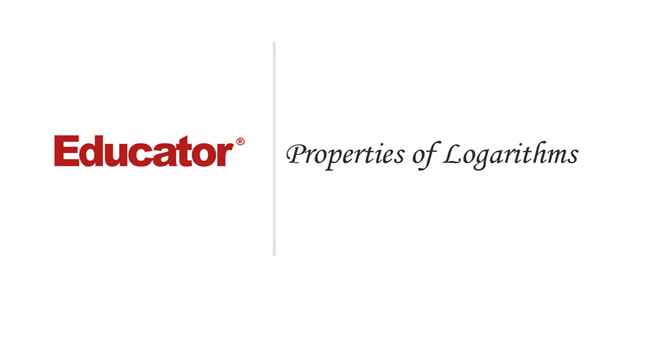Connecting...

This is a quick preview of the lesson. For full access, please Log In or Sign up.
For more information, please see full course syllabus of Algebra 2
For more information, please see full course syllabus of Algebra 2
Algebra 2 Properties of Logarithms
Lecture Description
This lecture covers the properties of logarithms. The first property you'll learn about is the product property. We can use this property to break the log apart, or to write two logarithms as a single log. The second property is the quotient property, which is very similar to the first one, and the third property is the power property, which allows us to move the exponent to the front. It is important to use these properties to solve logarithmic equations. To solve a logarithmic equation, first use the properties to combine logs on each side of the equation to get an equation of the form log x = log y. Then equate x and y.
Bookmark & Share
Embed
Share this knowledge with your friends!
Copy & Paste this embed code into your website’s HTML
Please ensure that your website editor is in text mode when you paste the code.(In Wordpress, the mode button is on the top right corner.)
×
Since this lesson is not free, only the preview will appear on your website.
- - Allow users to view the embedded video in full-size.
Next Lecture
Previous Lecture









































 Carleen Eaton
Carleen Eaton Grant Fraser
Grant Fraser
 Answer Engine
Answer Engine



0 answers
Post by Daniel Nie on August 10, 2019
In Example IV , when you checked for extraneous solutions, 18-21=-3, not -16
1 answer
Thu Mar 27, 2014 6:58 PM
Post by Christopher Lee on January 22, 2014
In the 4th step for example 1, you're missing a parentheses at the end.
1 answer
Thu Mar 27, 2014 6:57 PM
Post by Christopher Lee on January 22, 2014
At about 14:44, you wrote 4 log base 6 x^4, while since you used the power property, there should be no ^4.
1 answer
Thu Mar 27, 2014 6:56 PM
Post by Christopher Lee on January 22, 2014
At 3:41, shouldn't there be parentheses around x^2-3? Also, there should be a base of 3 when you wrote log y, otherwise it would mean it would have a base of 10.
1 answer
Fri Mar 1, 2013 10:50 PM
Post by Kenneth Montfort on February 26, 2013
I noticed that when you did example IV, you could get two potential factor options. If you subtracted 4x^2 from both sides, your factors end up being (2x + 3)^2, but when you leave the 4x^2 positive on the right, then your factors end up being (2x - 3)^2, why is this?
1 answer
Thu Feb 9, 2012 7:34 PM
Post by Edmund Mercado on February 8, 2012
Dr. Eaton:
At 27:24, did you mean that log16 (18-21)= log16 (-3) not a valid solution?